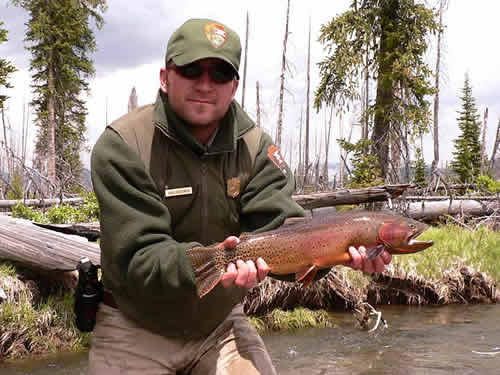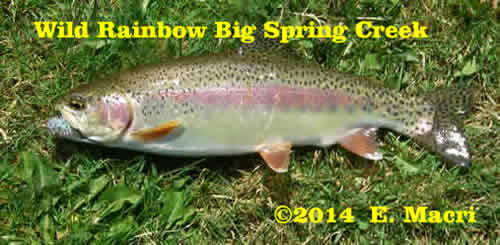Trout Stocking: Wild Trout Versus Stocked Trout
Sustainability and Aquatic Science
by
Eugene P. Macri Jr.

The arguments over stocked and wild trout continue after
over thirty years of debate. It's not an easy question and there are no easy answers. The real
problem is how do you wish to manage your fishery! In Pennsylvania despite the closure of one
of their largest hatcheries, Big Spring Fish Cultural Station in Newville Pennsylvania due to
the hatchery's destruction of Big Spring Creek, the Pennsylvania Fish and Boat Commission is still
trying to run it's program by massive hatchery put and take fishing. The hatchery was closed after a
long study : An Ecological Survey of Big Spring Creek with Emphasis on
the Effects of Fish Hatchery Effluent by Black and Macri. The hatchery wiped out the
stream due to its effluent. The state tried to lie about the destruction of the
stream and basically tried to cover it up for over 25 years. Our study with help from citizen's groups
and Penn Future forced the closure of the hatchery. Yet the state has learned nothing from this fiasco and
still has their license sales tied to hatchery trout production.
As I have shown elsewhere on this site you cannot
produce enough trout to satisfy anglers who chase hatchery trucks. The debate over to stock hatchery fish
over wild trout is a world
wide debate. Many countries have gone to triploids for
stocking waters with native strains of trout which makes sense. Some people will argue that if you have
stream with both wild and hatchery fish that no damage has been done. This is another fallacy by
politicians, fishery agencies, fishermen and even some highly trained biologists. What would the
fishery have been without the hatchery trout is never considered!

I am not of the opinion that hatchery trout and hatchery
trout production should be eliminated. I am of the opinion that it can be done with less pollution
and in a way that takes advantage of what you have without damaging streams with wild populations.
I have seen some streams and some I have managed where stocking another species seemed to do little
damage to native trout. This is especially true of putting brook trout in certain waters with
browns. The fish tend to compartmentalize the niches and I see little competition. However, the
number of fish stocked must be regulated with water supplies, seasonal fluctuations and fishing
pressure. And the stream must monitored at all times.
One of the best ways of deciding what to stock
especially in public waters is to categorize your streams based on scientific studies. However, most the
studies done by state agencies are seriously lacking in my estimation and consist of simplistic fish
population studies. This simple classification works fairly well if proper analysis is
used:
Macri's Trout Stocking Protocols
-
Categorize streams by environmental
quality
-
Streams Level 3:
Put and Take Streams; These streams may be marginal and most trout will not get through the
summer. This where you put many of your hatchery fish for the public to catch and
keep.
-
Stream Level 2:
Holdover streams. These streams have enough environmental quality where trout will holdover
and not necessarily reproduce. These are great restricted and catch and release streams
because they will furnish great economic rewards per fish stocked.
-
Stream Level 1D:
These streams tend to large waters with enough habitat, good water temperature and food
supply. The streams have a good population of wild and some hatchery trout hold overs. These
streams should only be stocked with fingerlings.
-
Streams Level
1C; These are streams which show some native populations and some holdover. Some wild
reproduction but low numbers. These streams should only be stocked with fingerlings of
either the same species or different species depending upon environmental conditions. These
streams may also be non fishing stream..lie fallow or serve as nursery waters. They often feed
large waters.
-
Stream Level 1
B: Potential Small Streams. Use Vibert Boxes with eggs. Try a few of these and see if
it works. These may be more remote waters or special waters that have shown possibilities
but you don't have resources to adequately address them.
-
Stream Level 1
A: Wild trout waters. Do not stock these streams. Monitor them! These are
rarer in the East but stocking them in most instances will only have negative effects. All catch
and release including flies or single hook artificial lures.
-
Stream Level
1S: These are limestone spring creeks. These are often are the finest
streams in a state. They should be managed if possible with wild trout and wild strains of trout.
Any project on these streams should be looked at carefully. Most state and federal agencies
have no clue on how to work on these streams let alone manage them. Most biologists also lack a
serious understanding of them. These streams are rare ecosystems and should be managed
accordingly. These streams should be no kill, catch and release. In most instance flies
only.
These protocols are not in stone but they serve as entry
point of stream stocking and management. The rule like that of Medical Doctor should be to
do no harm or in this case, do as little harm to the environment as possible. You cannot paint your
waters with a wide brush of stocking and management and expect a sustainable fishery in this
age.
| 
